The difficult survival of the first successful copper coin of Viceregal Mexico
by Pablo Luna Herrerabased on his website (in Spanish)
The issue of small (or low-denomination) coins by the official authority in the Viceroyalty period was always complicated, due to a currency shortage for centuries and few successful cases of low value copper issued in almost three hundred years.
The object of this study has its roots in multiple previous attempts by the Spanish Crown to mint copper coins of low value: some examples are:
1. Copper patterns of 1768 and 1769,
2. Silver quarters (named Lion and Castle type) produced from 1796 to 1816 (KM #62).
Regarding the latter, the increasing cost of manufacturing them, their inconvenient size, insufficient quantities struck Ben Nibert, Understanding the nomenclature of the colonial copper coinage 1814-1821 in U.S. Mexican Numismatic Association, Journal Vol IX. December 2004. No. IV. Hemet, California as well as the various Insurgent movements marked their end. Alfredo Lagunilla Iñárritu Alfredo Lagunilla Iñárritu, Historia de la Banca y Moneda en México. Editorial JUS. México D.F.,1981 points out that the silver “cuartillas” described above were insufficient to satisfy the needs for small change; even Viceroy Felix Maria Calleja in 1814 -when authorizing the coins that concern us- addressed the same reasons. Furthermore, Ricardo Fernández Castillo Ricardo Fernández Castillo, Los enigmas en la formación del sistema monetario mexicano durante la transición de la Nueva España al México independiente. Thesis to obtain the degree of Doctor en Historia. El Colegio de México, Centro de Estudios Históricos. México, 2019 explains the main objectives of issuing minor copper coins in the period were:
1. A response to the increasingly Insurgent money flows, mainly made of copper,
2. An attempt to extinguish the use of unofficial currency, such as tlacos, pilones, and other local coins,
3. Consolidation of the role of the Mexico City mint, struggling to achieve a path that would give it back the power lost since 1810,
4. To earn a position of useful and legitimate fiat currency, above its rebel counterparts.
In other words, the purpose was to facilitate retail trade and reduce the use of unofficial means of exchange, as well as to respond to the revolutionary issuers of fiduciary currency.
To understand why these coins were authorized at the end of the viceroyalty, we need to talk about the so-called “moneda del pueblo” (people’s currency), the existence of unofficial currency. José Enrique Covarrubias José Enrique Covarrubias, “La Moneda de Cobre en México 1760-1829. Una perspectiva administrativa”, in La Moneda en México 1750-1920, (J. A. Batiz & J. E. Covarrubias, coord), Instituto de Investigaciones Dr. José María Luis Mora. México D.F.,1998 explains why it was difficult to introduce small copper coins:
“Although the problems caused by the use of tlacos existed from early days of the colonial period, it was not until the middle of the 18th century that they began to be a reason for continuous discussions, to the point of inciting the highest authorities of the Spanish empire to a deep consideration of them themselves. Around 1760, laws and regulations are published on the conditions for circulation of the aforementioned tlacos. [...] The final intention [...] is none other than to request an official minting of copper coins that puts an end to the scams made by local merchants when they give and accept change [...]. The proposal, however, ran into opposition from the powerful Consulate of Merchants from Mexico City, reluctant to any initiative for copper coins endorsed by the king. For major businesses, a massive mintage of copper coins obviously represented the risk of having to admit official copper currency instead of their own money.”
Now we can understand that although the viceregal authority recognized the need to issue low-value copper coins (vellón) there was resistance and opposition given that New Spain was a silver economy, with privileges for major merchants. Moreover, the same author also mentions the technical difficulties in producing copper coins.
“One of the fundamental elements (in coining copper) was the lack of adequate techniques for casting and especially refining that metal […] the workers of the copper mines in the Michoacán area were not characterized by an innovative spirit regarding such works […] copper is a metal that comes in many different qualities and that often requires being properly refined to have it in its purest possible presentation, New Spain copper was from a low-quality purity”.
The technical troubles described before are another issue that helps to explain the lack of a national copper coin.
Whereas Enriqueta QuirozEnriqueta Quiroz, "La moneda menuda en la circulación monetaria de la ciudad de México. Siglo XVIII" in Mexican Studies/Estudios Mexicanos, 22(2), 2006, pp 219–249 explains that more than a problem of the lack of minor coinage, the issue was fractional values in the colonial economic system, the half or quarter real was not enough and these new coins were a proposal to solve the problem.
That same argument is subscribed by Luis Gómez WulschnerLuis Gómez Wulschner, “Vicisitudes de la Moneda de Cobre 1536-1861” in El Boletín Numismático No. 225 (Octuber -December 2009). Sociedad Numismática de México. México D.F., who mentions the following:
“In 1814, by order of Viceroy Félix María Calleja, copper was minted to correct the anarchy that prevailed in those times in relation to private minor coinage. Also, in order to achieve a monetary organization, since private issues, from villages and farms, counterfeits, etc. abounded.
On this occasion, the denomination was not expressed in maravedíes, instead it used the values that people knew, “but without giving them other names than those that remain settled.” This is how coins were minted in three values: two quarters, one quarter and one eighth, equivalent to one quarter, one eighth and one sixteenth of a real respectively. The intention was to extinguish the existence of tlacos and pilones.”
Now that we know the backgrounds it is time to move to the coin themselves: the introduction of the new copper coinage can be traced in different steps: on 28 March 1814 the Consejo Superior authorized the coining of small change (moneda de vellón) in New Spain; on 4 July Virrey Calleja authorized their minting; on 23 August he published the decree stating the denominations, for immediate circulation, and then, on 20 December, a proclamation ordered that prices be given in the new currencies and forbade their refusalBrad Yonaka, A variety guide to the silver and copper coinage of the Mexico City Mint 1772-1821, Agorocu Consulting Incorporated, United States, 2020.
Special emphasis needs to made regarding the authorization given by Viceroy Calleja to mint three new coins, -struck by his own initiativeibid. - he argued that: “…in order to prevent the existence of the hateful private currency as tlacos y pilones. We look to fight against the circulation of these types of coins and establish a safe national money for all the people in the State and for their interests…”
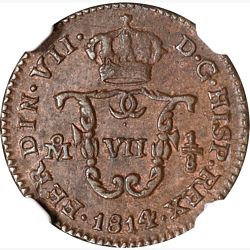
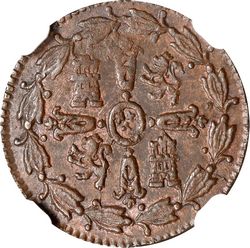
KM-63. 1814 1/8 Real (1/4 Tlaco) (Stack’s-Bowers NYINC Auction, 19 January 2023, lot 42616)
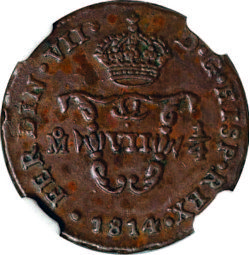
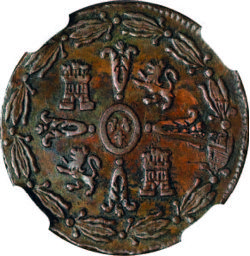
1/4 Real 1814. Stack´s Bowers, June 2022 World Collectors Choice Online auction, lot #72032
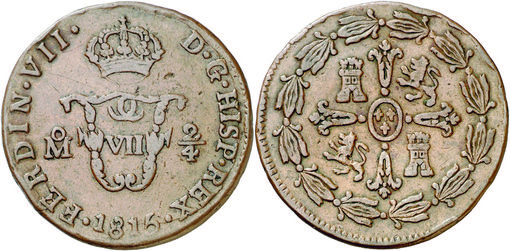
2/4 Real 1815. Aureo & Calico, auction 389, lot #148
The design of the coins is interestingfor more information, see Yonaka, op. cit., the aforementioned decree said: “… carrying on the obverse the name of our grand and beloved sovereign Ferdinand VII, the initial of the Royal Mint, and the sign that represent the value, in the other side the shield of Castilla and Leon…”
We can notice on the reverse two “F” letters intertwined and inside a “VII” at the center, all crowned, to the left the Mexico City mark and to the right the value, the inscriptions surrounding the coin “FERDIN-VII-D-G-HISP-REX” (Ferdinand VII by the grace of God King of Spain), and the date of the year in the exergue. On the obverse, surrounding a laurel wreath, is at the center the Bourbon shield with castles, lions and a fleur-de-lis.
However, it is relevant to notice that all the described designs were hybrid of two previous pieces already minted, on the one hand an 1808 Madrid proclamation medal of the same king and for the other side a Segovia 8 maravedis, as the following pictures illustrate:
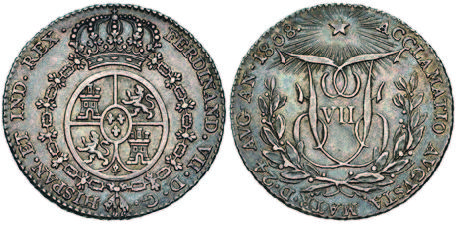
Ferdinand VII, proclamation medal, Madrid, 1808. Classical Numismatic Group, auction 363, lot #491.
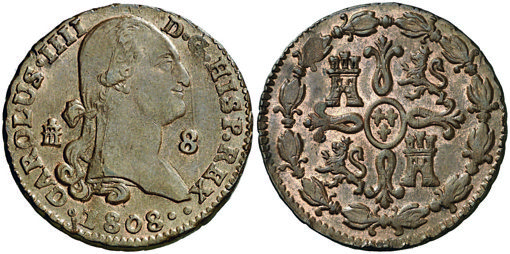
8 Maravedís 1808, Charles IV. Aureo & Calico, auction 258, lote #263
The ornate design on the obverse was originally created in 1770 by the engraver Tomas Francisco Prieto, together with the bust type monetary family (circulating since 1772 in Mexico).
Production started in July 1814. The quantity minted are the following:
| Year | Total production amount, all copper denominations, cumulative amount in pesos | |
| 1814 | 103,555 | All values produced. |
| 1815 | 101,356 | All values produced. |
| 1816 | 125,281 | Only ¼ and 2⁄4 produced. |
| 1821 | 12,50012,700 other authors | Only 2⁄4 produced. |
| Total | 342,962 | |
The mintage was irregular in the first three years of production. Pilar Gonzalez GutiérrezPilar Gonzalez Gutierrez, "Creación de la primera Casa de Moneda en Nueva España" in Estudios de Historia Social y Económica de América, No. 12, pp. 55-72. Universidad de Alcala. Espana, 1995 in her work records data from the Indies Archives in Spain, that shows the monthly production, and that any records were found regarding copper striking in 1821.
| Month | 1814 | 1815 | 1816 |
| January | 0 | 10,000 | 0 |
| February | 0 | 11,300 | 0 |
| March | 0 | 10,700 | 0 |
| April | 0 | 13,600 | 30,000 |
| May | 10,400 | ||
| June | |||
| July | 34,900 | 15,000 | 30,000 |
| August | 16,000 | ||
| September | 19,870 | ||
| October | 14,900 | 30,000 | |
| November | 17,000 | 30,000 | |
| December | 17,885 | 13,356 | 5,281 |
| Total: | 103,555 | 101,356 | 125,281 |
As a hypothesis, the reason why minting was suspended after three continuous years of fairly uniform production, is probably due to the appeasement of the war conflicts, which partially ceased by the middle of the decade, added to the sufficient quantity produced in stock. On the other hand, the reduced amount of production for the last year is likely due to the early conclusion of the viceregal administration, with multiple changes in 1821.
In addition, although the initial circulation was foreseen mainly for Mexico City, a significant amount of copper coin was sent to various areas of the ViceroyaltyFernández Castillo, op. cit,:
| Remittances of copper currency sent to other territories. (1815) | |
| Guanajuato | 8,500 pesos |
| Valladolid | 4,500 pesos |
| Querétaro | 3,000 pesos |
| Puebla | 10,000 pesos |
Further, Ben NibertNibert, op.cit. argues - with reason - that confusion exists in the collectors’ guild regarding the correct reading of the issued denominations, since their value was determined by three different factors: (i) the value engraved on the coin, (ii) the value granted by the government and (iii) the value named colloquially by the people: the same theory is shared by Brad YonakaYonaka, op. cit.. Therefore, the following information is provided for a better understanding:
| Value engraved: | Value Spanish system: |
Popular name: | KM# |
| 1/8 | 1/16 Real | Pilon (a half ) | 59 |
| 1/4 | 1/8 Real | Tlaco | 63 |
| 2/4 | 1/4 Real | Senal | 34 |
The reasons that caused the end of the copper coins are headed by the Independence movement, culminating in victory in the last year of production. However, it is well known that the production of silver coins with the royal bust continued beyond 1821; with the copper metal this was not the case due to:
- Rumors spread by the Insurgents that the issue of copper coins would withdraw all the silver and gold coins from circulation.
- It is a fact that the coins helped with previous trade issues related to minor coinage, but they also worsened the diversity of monetary types. That same explanation is shared by Brad Yonaka (2020) when he asserts “...The total coin produced were completely inadequate to the task of flushing out tlacos.”
- Rejection and resistance: business and shops preferred their own minor coinage (that gave them private benefits) to a national coin not regulated by them.
- Counterfeits.
Finally, the also named “Calleja coins” continued to circulate decades beyond, their total amortization (withdrawn for new coins) would not come until the Antonio López de Santa Anna administration in the 1840s.
For more information consult Chapter VI, page 203 to 235, Chapter VI, of La casa de moneda en México bajo la administración borbónica 1733-1821, by Victor Manuel Soria Murillo, available on the USMexNA online library.
